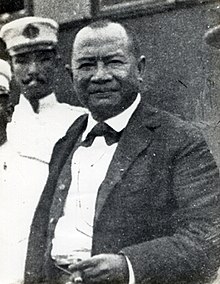Baldomero Aguinaldo
Baldomero Aguinaldo | |
|---|---|
 Baldomero Aguinaldo in 1899 | |
| Minister/Secretary of War and Public Works | |
| In office 15 July 1898 – 6 May 1899 | |
| President | Emilio Aguinaldo |
| Preceded by | Emiliano Riego de Dios |
| Succeeded by | Mariano Trías |
| Director of Finance | |
| In office April 1897 – November 1987 | |
| Preceded by | Position created |
| Succeeded by | Mariano Trías |
| Personal details | |
| Born | 27 February 1869 Cavite El Viejo, Captaincy General of the Philippines |
| Died | 4 February 1915 (aged 45) Manila, Philippine Islands |
| Resting place | Baldomero Aguinaldo Shrine |
| Spouse(s) | Petrona Reyes |
| Children | 2 |
| Alma mater | University of Santo Tomas |
| Awards | Cruz Roja del Merito Militar (Red Cross for Military Honor) |
| Nickname(s) | Baldo |
| Military service | |
| Allegiance | |
| Branch/service | |
| Rank | |
| Battles/wars | Philippine Revolution
|
Baldomero Aguinaldo y Baloy (27 February 1869 – 4 February 1915) was a leader of the Philippine Revolution. He was the first cousin of Emilio Aguinaldo, the first president of the Philippines, as well as the grandfather of Cesar Virata, a former prime minister in the 1980s.
Early life[]
Baldomero Aguinaldo was born in Kawit, Cavite. He was the son of Cipriano Aguinaldo y Jamir and Silveria Baloy. His father was the son of Eugenio Aguinaldo y Kajigas and Maria Jamir.
Education[]
He studied law at the University of Santo Tomas in Manila and was still a law student during the outbreak of the Philippine Revolution. He obtained a law degree, but failed to take the bar examination. Unable to practice law, he became a farmer.
Career[]
Aguinaldo organized, along with his cousin Emilio, the Magdalo chapter of the Katipunan in Kawit. He became president of the council. In the early days of hostilities, he always stayed at the side of his cousin Emilio. He fought in several bloody battles. He also led the Magdalo faction to the Katipunan which had its headquarters in Kawit, Cavite.
Aguinaldo's knowledge of the law and administrative procedures made him a valuable asset to the revolutionary government. He was appointed to several cabinet positions, and was a signer of two important documents: The Biak-na-bato Constitution, and the Pact of Biak-na-Bato.
During the Philippine–American War, Aguinaldo fought again, becoming commanding general of the revolutionary forces in the southern Luzon provinces. When hostilities ended in 1901, he retired to private life.
He held many various positions in the Aguinaldo Cabinet as Minister of National Defense[1]: 29 and Finance Minister. During the American occupation he became the President of the Philippine Veterans Association.[2]
Personal life[]
He was married to Doña Petrona Reyes with 2 children: Leonor and Aureliano. Leonor was the mother of former Prime Minister Cesar Virata. Aguinaldo was a member of the Philippine Independent Church (also known as the Aglipayan Church) as he saw independence from the Roman Catholic Church as a source of national pride.[3]
Death[]
Aguinaldo died in Manila of heart failure and rheumatism on February 4, 1915 at the age of 45 and was interred at the Manila North Cemetery. His remains were later exhumed and brought to his home in Binakayan, Cavite.
In popular culture[]
- Portrayed by Bayani Agbayani in the 2012 film, El Presidente.
- Portrayed by Gexter Abad in the 2013 TV series, Katipunan.
- Portrayed by Jan Urbano in the 2014 film. Bonifacio: Ang Unang Pangulo.
References[]
- ^ Sonnichsen, A., 1901, Ten Months a Captive Among Filipinos, New York: Charles Scribner's Sons
- ^ "Gen. Baldomero Aguinaldo Shrine | Cavite".
- ^ Gonzales, Enrique. “The Baptismal Rites in Filipino Christian Churches.” Philippine Studies, vol. 16, no. 1, 1968, pp. 160–168. JSTOR, www.jstor.org/stable/42720578
- 1869 births
- 1915 deaths
- People from Kawit, Cavite
- Filipino generals
- People of the Philippine–American War
- People of the Philippine Revolution
- Secretaries of National Defense of the Philippines
- Paramilitary Filipinos
- University of Santo Tomas alumni
- Aguinaldo family
- Aguinaldo Administration cabinet members
- Burials at the Manila North Cemetery
- Members of the Philippine Independent Church